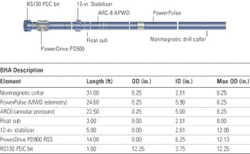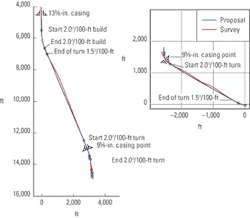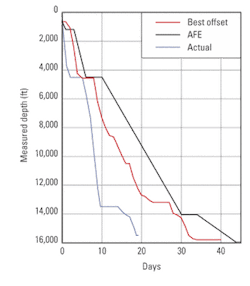Rotary steerable system helps deliver best performance in Grand Isle
Wayne Wisniewski
BP America Inc.
Jeff Hamer and John Vickrey
Schlumberger
BP America's use of the "beyond the best" process to plan and drill Grand Isle block 90-A2 on the US Gulf of Mexico shelf led to record results. Using a rotary steer-able drilling system, the wellsite team reached total depth in less than 20 days, more than 50% faster than was achieved on the best offset well and 60 days faster than the field average. The well was completed with no health, safety, or environmental issues, achieved all drilling objectives, and cost 52% less than budget, which represented a $4.2-million savings.
Well GI 90-A2 was the first BP project on the Gulf of Mexico shelf to employ the full suite of tools encompassed by the "beyond the best" process. The Schlumberger PowerDrive rotary steerable system (RSS) used to drill the 12 1/4-in. section in one tool run was instrumental in achieving the cited results.
Planning methodology
Believing that great performance is achievable lies at the foundation of BP's current business philosophy. As such, the BP culture drives its employees to reach beyond the status quo – not just the internal status quo, but also that of the wider industry at large. Before creating the actual technical plan for drilling GI 90-A2, a rigorous pro forma schedule was set for the team, and data was collected to support pushing the limits of all assumptions held by those working on the project.
The "beyond the best" process includes four modules:
•Right scoping – conducted early on to ensure that the desired production results are best achieved by the current well plan
•Drilling value assurance – requires peers to review the project plan and guarantee that sufficient resources, including time, are on hand to accomplish the stated goals
•No drilling surprises – involves integrating knowledge and technologies from all involved disciplines, including contingency planning, to optimize the drilling process
•Technical limits – explores a series of questions to define the very best performance objectives that a given project can be expected to attain.
Drivers of the GI 90-A2 "beyond-the-best" process included the project leader, engineers, drilling foreman, and key service company personnel. The lead drilling engineer (project leader) determined which tools the drilling operations team would have available to accomplish the defined goals and built a plan to incentivize the crew to perform to their personal best. Incentives would be allotted only if the lofty drilling objectives were met.
Planning in action
The GI 90-A2 engineering team began by exploring offset well and drilling data relevant to setting a range of expectations for what could be achieved given current drilling technologies. During technical limits meetings, the focus was on improving high impact items, such as rate of penetration (ROP). For example, the team discovered that working to increase ROP by 30% had a much larger impact on performance than improvements in running casing or tripping. A conscious decision was made to ensure that the big issues were correctly addressed, even at the expense of omitting smaller items. Priorities were chosen and agreed to by the team.
Despite the fact that 40 days was the best Grand Isle drilling record to date, the engineering team advised those setting technical limits for the GI 90-A2 that a 12-day target was feasible using rotary steerable technology. After discussion and the creation of a firm plan to modify a number of processes, the technical limits group finally chose a drilling target of 16 days using rotary steerable technology.
Among the processes that had to be addressed in order to reach the 16-day goal using PowerDrive RS technology were hydraulics and cuttings disposal. A 6 5/8-in. heavy weight drill pipe was selected to allow for the higher mudflow rates possible with the RSS.
By eliminating the requirement of running a mud motor and instead using an RS system, the pressure drop in the bottom hole assembly was greatly reduced, allowing for higher flow rate with the same stand-pipe pressure. This allowed better hole cleaning, which was critical when producing the faster drill rates that were anticipated from the RSS.
As for cuttings disposal, new shale shakers had just been installed on the rig being used; however, the team would take the time to ensure that all equipment was in top working order prior to spudding the hole by conducting a solids removal equipment audit. More personnel were assigned to the rig to ensure that the cuttings disposal equipment ran effectively throughout the project. Of note, given the chosen drilling technique, the cuttings generated would not need to be cleaned or dried prior to disposal overboard. Specifically, the RSS would produce large-sized cuttings with less total surface area to retain oils, versus those produced by a faster spinning yet slower drilling mud motor. Further, the cuttings would stay in the annulus a shorter period of time, thanks to the high flow rates. This eliminated the need for cuttings dryers, saving expense, and the reclaimed synthetic mud product could be reused during drilling. In the end, the mud-handling systems would be able to perform well with a drilling ROP of 200 ft/hr and up to 300 ft/hr instantaneous, sufficient to reach the stated goals. Oil on cuttings retention for the project was 6.1%, which is less than the newly mandated EPA maximum for synthetic mud cuttings.
Another potential bottleneck clarified and eliminated by the team was the previously inefficient use of various paper and electronic documents to routinely update the official drilling plan at the wellsite. The solution was to create a single digital well planning document, to be managed by the project's drilling engineer and housed on BP's central server. All types of documents created to support the project, whether spreadsheets, photos, text files, or other, would be archived and dated in a single document, accessible using a common document reader. This would ensure that anyone accessing the document would view the latest project plan, eliminating potential process errors.
It cannot be overstated that lively discussions among the team members, and establishing trust and a commitment to high performance among all players, led to the identification of an aggressive drilling plan and the elimination of all potential bottlenecks in the process chain for drilling the GI 90-A2. In the end, the team was confident with its decisions and ability to carry out the established plan.
Execution
According to plan, after the 13 3/8-in. casing was set at about 4,500 ft, a 12 1/4-in. PowerDrive system and its associated bottom-hole assembly began drilling a vertical 12 1/4-in. hole. A kickoff from vertical was achieved to build 2°/100 ft and turn 1.5°/100 ft to a planned tangent section at 23° deviation. The team's ability to meet its objectives would be determined by the crew's ability to maximize the RS system's performance while drilling from 4,500 ft to 13,575 ft – a 9,075-ft-long section.
While drilling, however, a change in plan occurred. One of the resources that the BP staff used to ensure that the well intersected the desired reservoir section was a highly immersive visualization environment (HIVE), which allowed real-time drilling visualization. In fact, a HIVE session conducted while drilling led to a slight modification of the well path through the intermediate section. The RSS drilling team therefore had to make midstream course corrections. Had a downhole mud motor been used to steer the bit, the sliding required to accomplish the course corrections would have negatively impacted ROP, and drilling rates would have decreased significantly. Given the total three-dimensional steering capability of the RSS, the course change did not impact drilling efficiency at all.
The team drilled the longest and fastest 12 1/4-in. section in Grand Isle's history, even with the course correction. The section was drilled in five days with one bit run using the PowerDrive and a Hycalog RS130 bit. The field's previous best was 14 days. The 9 5/8-in casing shoe was set at 13,575 ft.
The crew reached TD, which penetrated the top of the UM4 sand in less than 20 days, had no health, safety, or environmental incidents, and received full bonuses for its high performance. At final tally, well GI 90-A2 was drilled for 52% less than budget, saving $4.2 million. The RS system demonstrated that this type of technology can dramatically lower the cost of drilling lower tier, shelf-type wells.
Next steps
Although laudable results were achieved with the GI 90A-2 well, BP continues to reach for additional performance gains in its GoM, shelf-wide drilling campaign. The team believes that it is technically possible, given optimum performance of every component in the drilling plan, including use of an RSS in the 12 1/4-in. section, to drill a Grand Isle-type well in less than 12 days. In fact, the same BP drilling team recently drilled an 11,500-ft well in Eugene Island for $1 million – a step change and record company performance in the Gulf.
Bottom line, high expectations, appropriate data and support, state-of-the-art technology, and a team willing to push the limits – including its own initial doubts – led to the drilling performance breakthrough at Grand Isle, and that same performance is continuing throughout the Gulf of Mexico shelf today.



